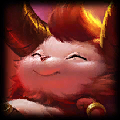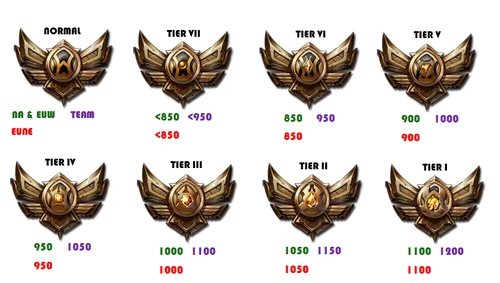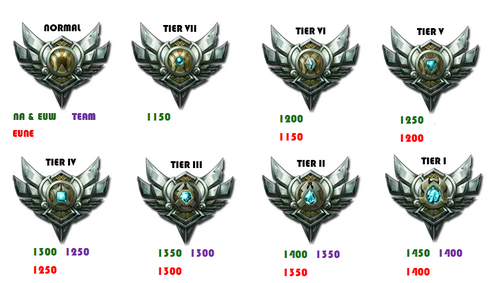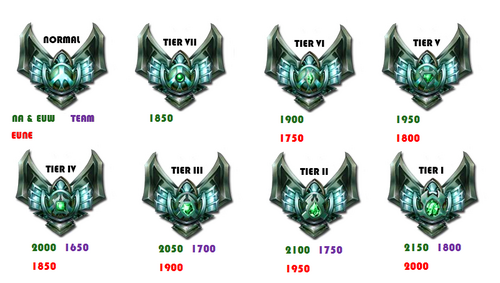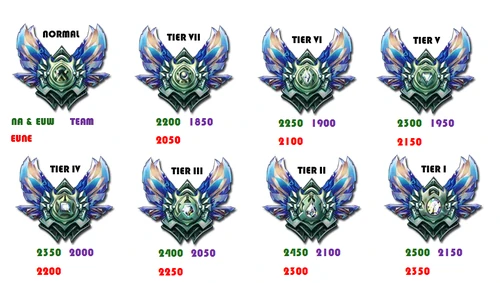Elo rating system was used in League of Legends ranked games prior to Season Three when the League system was introduced.
The Elo rating system is a method for calculating the relative skill levels of players, originally designed for two-player games such as chess. It is named after its creator Arpad Elo, a Hungarian American physics professor and chessplayer.[1] The Elo system was invented as an improved chess rating system, but today it has been adapted for use in many other games. Variations of it are also used as a rating system for multiplayer competition in a number of games and has been adapted to team sports including association football, American college football and basketball, and Major League Baseball.
In League of Legends the Elo rating of a player was used by the matchmaking in ranked games to find other players of a similar skill level to play with/against before the introduction of the League system in Season Three. Elo was not used for custom and Co-op vs. AI games. The Elo rating for ranked games was different for each type of queue: 3v3 arranged, 5v5 solo and 5v5 arranged teams. The rating was only visible for ranked games after 5 games played in a certain queue type. Players were awarded with medals in their summoner profile based on their Elo at the conclusion of Season One and Season Two. These medals were given as follows:[2]
- Bronze (Old): Between 1250 and 1399 (3v3: 1249-1409, pre-made 5v5: 1249-1409) (Top 25%)
- Silver (Old): Between 1400 and 1519 (3v3: 1410-1519, pre-made 5v5: 1410-1499) (Top 10%)
- Gold (Old): Between 1520 and 1899 (3v3: 1520-1699, pre-made 5v5: 1500-1749) (Top 3%)
- Platinum (Old): 1900 and above (3v3: 1700+, pre-made 5v5: 1750+) (Top 0.2%)
About a month before the end of Season 2, a new rating tiers system was introduced:[3]
- Bronze: Between 0 and 1149 (Team: 0-1249) (Top 100%)
- Silver: Between 1150 and 1499 (Team: 1250-1449) (Top 68%-13%) Majority of Active Player Base
- Gold: Between 1500 and 1849 (Team: 1450-1649) (Top 13%-1.5%)
- Platinum: Between 1850 and 2199 (Team: 1650-1849) (Top 1.5%-0.1%)
- Diamond: 2200 and above (Team: 1850+) (Top 0.1%)
In addition, rankings were subdivided into smaller sections, like Bronze V or Gold II. These are sectioned off every seventy points of elo (1150-1220 is Silver V, 1220-1290 is Silver IV, etc.).
These were the tiers for the North American platform, they differed a bit for other platforms.
Calculating Elo
The specific formulas which were used for Elo calculations in League of Legends are unknown. However, most Elo implementations share the same basics as that originally designed for chess. A brief summary is given below. For a more detailed discussion, see Wikipedia.
It is assumed that a person's performance varies from game to game in approximately a normal distribution and a person's Elo rating was the mean of that distribution. A person with a higher Elo may perform better on average than a player with a lower Elo, although usually it was mainly to do with the teamwork around that player. This score was determined entirely by win/loss statistics in relation to other players. For players A and B with respective Elo ratings of Ra and Rb the expected victorious outcome Ea of the game for player A was given by the following formula:
For every difference of 400 points, the team/player with the higher score is ten times as likely to win as the other team/player. This standard is for Chess and may have been different in League of Legends. After a game the actual outcome was compared to the expected outcome and each team/players rating is adjusted to bring them closer to where they should actually be. As a result, if a team was expected to win and does their score changes less than if they were expected to lose and instead won. Successive games would have eventually brought each player/team to a point where they were expected to win 50% of the time against opponents of equal score.
A player's change in rating was linear to the difference between the expected outcome and the actual outcome. It was given by the following formula where Sa is the result of the game and is presumably 1 for a win and 0 for a loss.
The magnitude of the score change was determined by the player's K value and other things, like a server crash (When the score you get is 50%). In chess initially this K value is big (25 for their first 30 games) resulting in large changes in Elo. This is so a player can rapidly find her or his correct place in the ranking system. As their number of wins and losses became more even this K value was reduced to prevent dramatic changes in Elo against evenly matched opponents (K = 15 to 7). This also prevented inflation in ratings at high Elo play. It appears that League of Legends used a similar system of changing K values: K appeared to be starting around 100, eventually leveling out to about 25.[4]
All players started ranked play with an Elo of 1200 for their first 10 games at level 30. From there they were assigned a score and changes are made as normal.[5]
Elo decay
Prior to the Season 2 rating system remake, Elo decayed over time when you were above 1400 Elo:[6]
- Elo decayed at a rate of 50 Elo for Diamonds, 35 Elo for Platinums, 25 Elo for Golds, 10 Elo for Silver, and 0 Elo for Bronze for every 4 consecutive weeks of inactivity and every 7 days thereafter.
- For normal rating, inactivity was defined as no activity in any queue.
- For ranked rating, inactivity was defined as no activity in the specific queue (arranged 5x5, arranged 3x3, and solo/duo 5x5 are all tracked separately). Ranked decay only applied to people who were ranked above 1400 rating.
- The decay timer was reset after a game was played in that specific queue.
Other ELO facts
- Elo changes were higher for the first ~50 games ranging from 50-13.
- Duo-queuing never affected elo gains/losses.
- The Elo rating showed only after the first 5 games, but elo placement required 10 games.
- The Chinese servers still use the Elo Rating System because of the bugginess of the League system in their client.[7]
